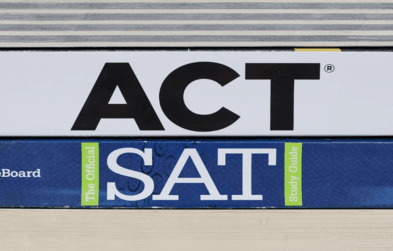How are the SAT and ACT Different?
Looking to learn about the differences between the SAT and ACT tests? Everything from test structure and content to scoring systems.
Choosing the right college entrance exam can be a challenging task for any student, and with the two most popular options being the SAT and the ACT, it can be overwhelming to decide which one to take. While both exams are accepted by most colleges and universities, they differ significantly in structure and content. Understanding these differences can help you make an informed decision about which test to take. In this blog post, we will break down the differences between the SAT and the ACT.
How are the ACT and SAT different?

As you prepare to take the first step into your collegiate career, it is important to know what requirements there are to get in. Most colleges require you to take some sort of entrance exam, two of which are the ACT and the SAT. These standardized exams are designed to assess the college readiness of students.
There are some major differences between the two, so you need to pick the right exam for you. To help you decide which exam to take, we will break down the differences between the two exams.
SAT vs ACT Section Breakdown
SAT Section Breakdown
Reading and WritingThe SAT Reading and Writing section, a two-stage adaptive test, evaluates comprehension, analysis, and reasoning skills in interpreting information from texts and graphics. It will assess your ability to understand academic words in context, evaluate texts rhetorically, and connect ideas. Students will also refine written expressions in line with specified rhetorical goals for a comprehensive assessment.
MathThe SAT Math section evaluates your problem-solving abilities and mathematical understanding across various domains. Tasks include interpreting and solving problems using linear and nonlinear equations, applying quantitative reasoning to solve percentage and data analysis problems, and proficiently solving geometric problems related to length, area, volume, and scale factors.
ACT Section Breakdown
ReadingThe ACT Reading section measures your reading comprehension skills and your ability to answer questions about a text. It includes four passages of different lengths, some of which may require you to compare texts and interpret them.
EnglishThe ACT English section of the test assesses a student's command of the language, including grammar, cohesion, and vocabulary. It aims to evaluate your ability to communicate effectively through writing and to identify potential errors that could affect your academic career.
MathThe ACT Math section focuses on topics generally encountered by the beginning of 12th grade. It is written to emphasize reasoning and application of math, not the memorization or plugging numbers into formulas just to solve for answers. Calculator is allowed for all questions.
ScienceThe ACT Science section covers most of what would have been taught in high school to students. It covers many subjects, such as biology, chemistry, physics, Earth science, and space science. Within these topics, the questions focus on the skills you need to succeed in college such as data interpretation.

Start preparing for theSAT today
Take a 15 minute test and get yourAnalytics Report!
SAT vs ACT Questions Breakdown
SAT Section Breakdown
Reading and Writing: Module 1- 25 operational questions and 2 pretest questions
- 32 minutes
- Subject Areas: Literature, history/social studies, humanities, science
- Question Distribution:
- Information and Ideas: 6~7 questions
- Craft and Structure: 6~8 questions
- Expression of Ideas: 4~6 questions
- Standard English Conventions: 5~8 questions
- 25 operational questions and 2 pretest questions
- 32 minutes
- Subject Areas: Literature, history/social studies, humanities, science
- Question Distribution:
- Information and Ideas: 6~7 questions
- Craft and Structure: 6~8 questions
- Expression of Ideas: 4~6 questions
- Standard English Conventions: 5~8 questions
- 22 questions
- 35 minutes
- Subject Areas: Science, social studies, real-world topics
- Calculators allowed for the entire math section
- Question Distribution:
- Algebra: 6~8 questions
- Advanced Math: 6~8 questions
- Problem-Solving and Data Analysis: 2~4 questions
- Geometry and Trigonometry: 2~4 questions
- 22 questions
- 35 minutes
- Subject Areas: Science, social studies, real-world topics
- Calculators allowed for the entire math section
- Question Distribution:
- Algebra: 6~8 questions
- Advanced Math: 6~8 questions
- Problem-Solving and Data Analysis: 2~4 questions
- Geometry and Trigonometry: 2~4 questions
Total:
98 questions in 2 hours 14 minutes
ACT Questions Breakdown
Reading- Main ideas and details about the passages: 21 to 24 questions
- Craft and Structure of the Writing: 10 to 12 questions
- Integration of Knowledge and Ideas: 6 to 9 questions
- 35 minutes, 40 questions
- Production of the English language: 22 to 24 questions
- Knowledge of the English language: 11 to 13 questions
- Conventions of the English language: 39 to 41 questions
- 45 minutes, 75 questions
- Number and quantity: 5 to 7 questions
- Algebra: 7 to 9 questions
- Functions: 7 to 9 questions
- Geometry: 7 to 9 questions
- Stats and Probability: 5 to 7 questions
- Integrating essential skills: 24 to 26 questions
- All multiple choice
- 60 minutes, 60 questions
- Biology: 2 passages, 11 to 15 questions
- Chemistry: 1 to 2 passages, 5 to 15 questions
- Physics: 1 to 2 passages, 5 to 15 questions
- Earth and Space Science: 1 to 2 passages, 5 to 15 questions
- 35 minutes, 40 questions
Total:
215 questions in 2h 55 min

Start preparing for theACT today
Take a 15 minute test and get yourAnalytics Report!
SAT Scoring
In the SAT, scores for each section are calculated independently before being combined. The Math section and the Reading and Writing section are both graded on a common scale, each carrying a maximum of 800 points. In total, an SAT score can range from 400 to a maximum of 1600 points.
ACT Scoring
The ACT is much simpler to figure out. Each section is out of 36 points, and the composite score is simply the average of all four sections of the exam. When you get an ACT score report, it will give you a composite as well as each section's score. Some schools will even take what is called a super score, where they look at your best score from each section over multiple tests. So if you retake the ACT and do better on specific sections, your super score can improve.
What part of the US takes the ACT or SAT? Does it matter where I live?

While both tests have become widely accepted, there are still regional differences. Traditionally, the SAT has been taken by students in coastal states and colleges. The ACT was more heavily taken and required by midwestern states. Colleges and universities do not have a preference, but it never hurts to check entrance requirements to make sure your school isn’t one of the few that looks for a specific exam.
Even today, most coastal students take the SAT and midwestern students take the ACT but the number of students taking each is slowly approaching a more even spread throughout the country.
Conclusion
Choosing between the SAT and the ACT can be a challenging decision, but understanding the differences between the two can help you make an informed choice. The SAT focuses on reading comprehension, writing skills, and math, while the ACT includes an additional science section and emphasizes reasoning and application of math concepts. Both exams are scored differently, with the SAT being out of 1600 and the ACT out of 36. While regional differences exist in the popularity of each exam, colleges and universities generally accept either. It is essential to research your target schools' admission requirements to determine if they have a preference. Ultimately, preparing for and taking the exam that aligns with your strengths and skills is crucial to achieving your desired score and gaining admission to the college of your choice.
Let R. test set a smart path for you! Discover your strengths and weaknesses with R. test Let R. test set a smart path for you! Discover your strengths and weaknesses with R. test